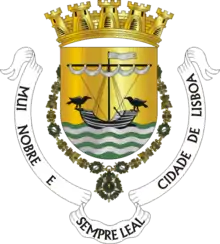Port of Lisbon
The Port of Lisbon (Portuguese: Porto de Lisboa) is the third-largest port in Portugal, mainly on the north sides of the Tagus's large natural harbour that opens west, through a short strait, onto the Atlantic Ocean. Each part lies against central parts of the Portuguese capital Lisbon. Due to its strategic site between Europe, Africa, and the Atlantic, it is one of the most accessed and used in Europe. For container ships it begins with a 1080-metre mooring, with cranes, south of a thin, rectangular, pleasure boat marina. It is north-east of the centre of the strait-spanning suspension bridge, the Ponte 25 de Abril. Continuations are to the north-east. These are a bank-side cruise ship terminal next to the old Alfama district, followed by multi-use harbour-side terminals at Xabregas, Grilo, Beato ([ˈbjatu])) and Braço do Prata, Marvila (Lisbon).
| Port of Lisbon Porto de Lisboa | |
|---|---|
.jpg.webp) | |
| Location | |
| Country | Portugal |
| UN/LOCODE | PTLIS[1] |
| Statistics | |
| Website Official Website | |
Denser military docks are beyond a headland to the south-east – Lisbon Naval Base, long colloquially synonymous with Alfeite, a slightly wider, once royally-owned, district.
History
There are data on human presence in the Tagus estuary since prehistory. Probably the Phoenicians were in this area in the 12th Century BC and they would create a commercial port in the north margin of the River Tagus. In 205 BC, the city (known as Olissippo) was conquered by the Romans. In the 5th Century the Suebi conquered the area, followed by the Visigoths. In AD 714, the Moors conquered Lisbon, expanding the port with their Mediterranean and Atlantic trades.
Manuel Antunes Frasquilho was President of the Port of Lisbon Administration (APL), from 2005 to 2009, during which he implemented the Plano Estratégico do Porto de Lisboa (Strategic Plan for the Port of Lisbon), a massive long term modernization and development plan, aimed at increasing port traffic, efficiency, and accessibility.[2][3] Frasquilh was elected President of the RETE – Association for the Collaboration between Ports and Cities in 2005.[4][5][6][7]
Gallery
References
- "UNLOCODE (PT) - PORTUGAL". service.unece.org. Retrieved 27 April 2020.
- Jornal de Negócios - Porto de Lisboa vai reforçar tráfego de contentores por via férrea e fluvial
- Transportes em Revista - Manuel Frasquilho: Presidente da APL «O Porto de Lisboa é para continuar»
- Porto de Lisboa - Associações a que a APL pertence e trabalho desenvolvido
- Porto de Lisboa - Presidente do Porto de Lisboa eleito para a presidência de organização internacional de colaboração entre cidades e portos
- RETE Digital - Manuel Frasquilho
- RTP - Porto Lisboa define plano estratégico com aposta mercadorias e turismo
.jpg.webp)
.jpg.webp)
